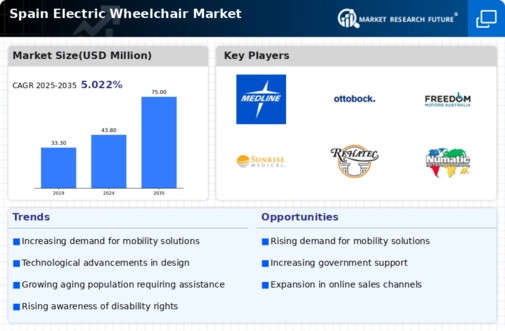Rising Healthcare Expenditure and Accessibility
In Spain, rising healthcare expenditure is a significant driver for the electric wheelchair market. The government has been increasing its investment in healthcare services, which includes funding for mobility aids. This trend is likely to enhance accessibility for individuals requiring electric wheelchairs, as more healthcare providers are incorporating these devices into their offerings. The electric wheelchair market stands to gain from this increased funding, as it may lead to more subsidies and financial assistance programs for consumers. Additionally, as healthcare costs rise, individuals are more inclined to seek out effective mobility solutions that can improve their quality of life. This growing recognition of the importance of mobility aids in healthcare is expected to bolster the market, as consumers become more aware of the benefits of electric wheelchairs.
Aging Population and Demand for Mobility Solutions
The aging population in Spain is a crucial driver for the electric wheelchair market. As the demographic shifts, the need for mobility solutions becomes increasingly pronounced. By 2025, it is projected that over 20% of the Spanish population will be aged 65 and older. This demographic is more likely to experience mobility challenges, thus driving demand for electric wheelchairs. The electric wheelchair market is responding to this trend by offering products that cater to the specific needs of older adults, including enhanced comfort and ease of use. Furthermore, the increasing prevalence of age-related conditions such as arthritis and osteoporosis further fuels the demand for electric wheelchairs, as these conditions often necessitate mobility aids. Consequently, the market is likely to see sustained growth as manufacturers innovate to meet the needs of this expanding consumer base.
Increased Focus on Rehabilitation and Independence
The emphasis on rehabilitation and independence for individuals with mobility challenges is driving the electric wheelchair market in Spain. Rehabilitation programs increasingly incorporate electric wheelchairs as essential tools for enhancing mobility and promoting independence among users. This focus aligns with broader societal trends that prioritize the integration of individuals with disabilities into everyday life. The electric wheelchair market is responding by developing models that are not only functional but also designed to empower users. By providing greater autonomy, electric wheelchairs facilitate participation in social activities and community engagement. As rehabilitation practices evolve, the demand for electric wheelchairs is likely to grow, reflecting a societal commitment to inclusivity and support for individuals with mobility impairments.
Technological Innovations Enhancing User Experience
Technological advancements play a pivotal role in shaping the electric wheelchair market. Innovations such as improved battery life, lightweight materials, and advanced control systems are enhancing user experience significantly. For instance, the introduction of smart technology in electric wheelchairs allows for features like remote control and health monitoring, which are becoming increasingly popular among users. In Spain, the market is witnessing a shift towards more sophisticated models that integrate these technologies, appealing to a tech-savvy consumer base. The electric wheelchair market is likely to benefit from these innovations, as they not only improve functionality but also increase the overall appeal of electric wheelchairs. As a result, manufacturers are investing in research and development to create cutting-edge products that meet the evolving demands of consumers, potentially leading to a competitive edge in the market.
Growing Awareness of Disability Rights and Accessibility
The growing awareness of disability rights and the importance of accessibility is a notable driver for the electric wheelchair market in Spain. Advocacy for the rights of individuals with disabilities has gained momentum, leading to increased public discourse on the need for accessible environments. This societal shift is influencing policy changes and encouraging businesses to adopt more inclusive practices. The electric wheelchair market is benefiting from this heightened awareness, as consumers are more likely to invest in mobility solutions that enhance their quality of life. Furthermore, as public spaces and transportation systems become more accommodating, the demand for electric wheelchairs is expected to rise. This trend reflects a broader commitment to ensuring that individuals with disabilities can navigate their communities with greater ease and dignity.




















Leave a Comment